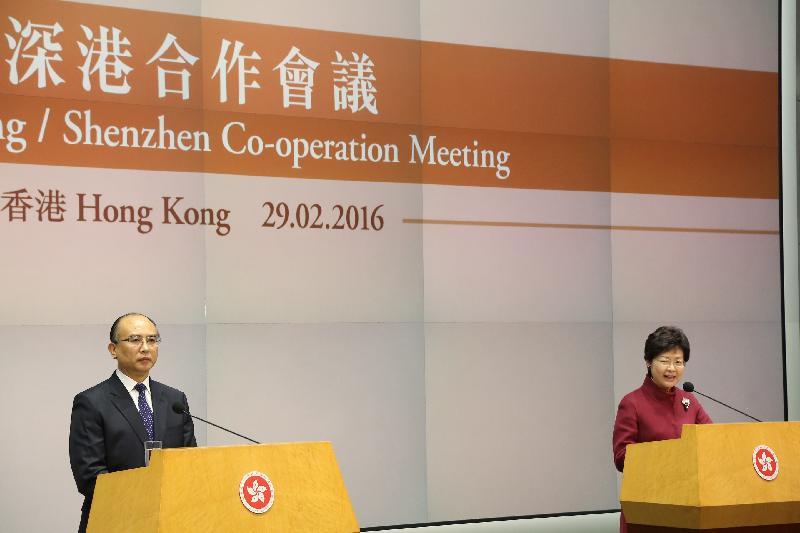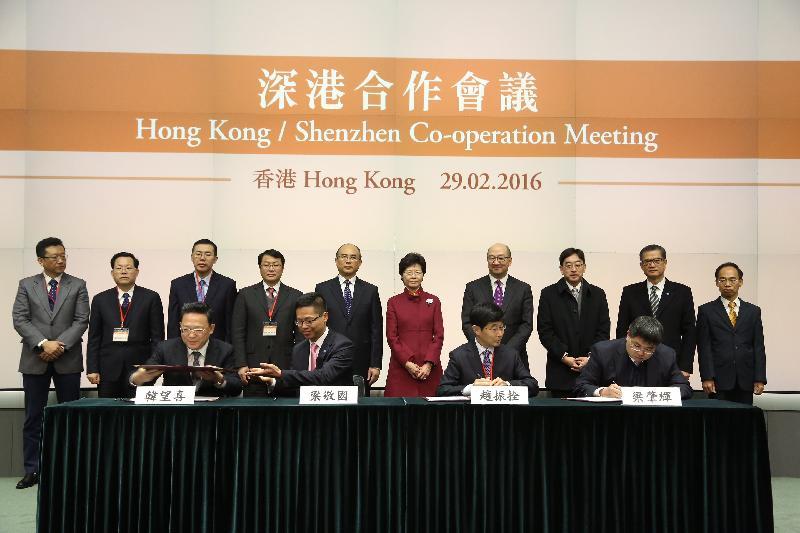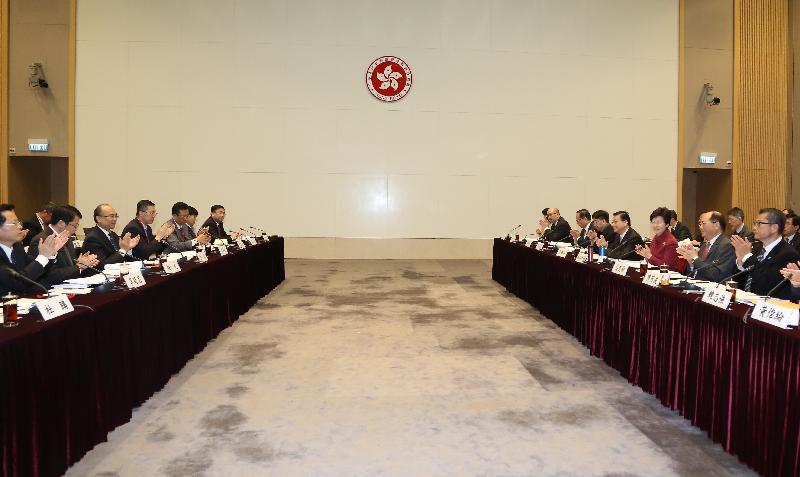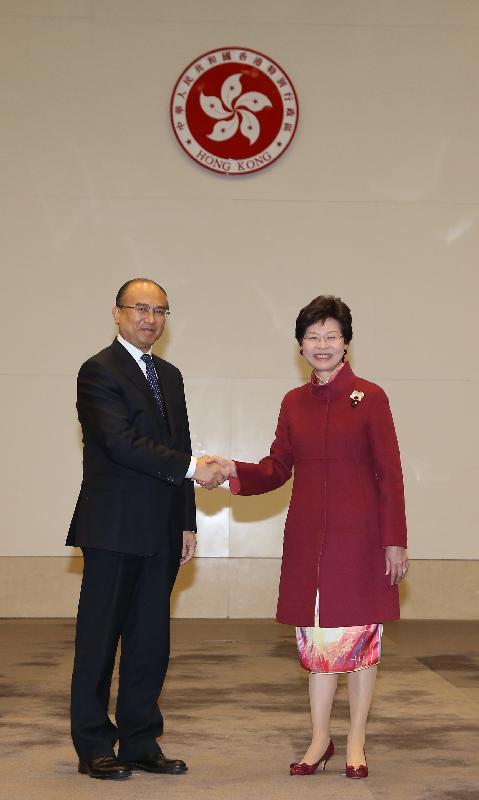CS and Mayor of Shenzhen co-chair Hong Kong/Shenzhen Co-operation Meeting (with photos)




The Chief Secretary for Administration, Mrs Carrie Lam, and the Mayor of the Shenzhen Municipal Government, Mr Xu Qin, co-chaired the Hong Kong/Shenzhen Co-operation Meeting in Hong Kong today (February 29). Relevant officials of the Hong Kong Special Administrative Region (HKSAR) and the Shenzhen Municipal Government attended the meeting.
Mrs Lam said, "Over the past year, with the concerted efforts of the Hong Kong and Shenzhen governments, good progress has been made on various areas of co-operation. 2016 marks the beginning of the implementation of the National 13th Five-Year Plan. The Proposal on Formulating the 13th Five-Year Plan promulgated by the Central Authorities states clearly that the Mainland will step up efforts to further open up its market to Hong Kong and Macao, and enhance co-operation and exchanges between the Mainland and Hong Kong/Macao in areas including social policies, livelihood issues, culture, education and environmental protection, and speed-up of the construction of various Guangdong-Hong Kong-Macao co-operation platforms including Qianhai. I hope that against this important background, the two sides will deepen co-operation in various areas under the principles of complementarity and mutual benefits in the coming year to bring benefits to the people in both Hong Kong and Shenzhen."
In the meeting, both sides reviewed the achievements made in the past year and set out the direction for co-operation in key areas including innovation and technology, creative industries, financial services, professional services and youth co-operation in the coming year. The progress of co-operation as well as the direction for future co-operation in individual areas are outlined below.
Innovation and Technology
In 2015, the HKSAR Government formally established the Innovation and Technology Bureau to co-ordinate, support and complement the development of Hong Kong's innovation and technology industry. Since the Karolinska Institutet of Sweden decided to establish its first overseas research facility in Hong Kong, the Government, together with the Municipal Government of Shenzhen and Karolinska Institutet, has already commenced preparation for the establishment of a tripartite task force to explore concrete co-operation projects, so as to make full use of the strengths of Hong Kong and Sweden on regenerative medicine research, as well as the strong industrialisation capability of Shenzhen. It is hoped that the task force can open up a new mode of co-operation between the two places.
Exchanges between innovation and technology professionals of the two places have become increasingly frequent. The Hong Kong Information Technology Joint Council and the Shenzhen Computer User Association signed the "Agreement on Exchange, Co-operation and Mutual Qualification Recognition of Shenzhen Hong-Kong ICT Talents" in March last year, and introduced the "Shenzhen/Hong Kong Chief Information Officer (CIO) Reciprocal Recognition Scheme" under the Agreement at the end of last year. Results of the Reciprocal Recognition will be announced in the first half of this year.
In the 2016 Policy Address, the Chief Executive announced that $2 billion would be set aside for setting up an Innovation and Technology Venture Fund for co-investing with private venture capital funds on a matching basis. The HKSAR Government believes that the measure can attract more venture capital funds, including capital from Shenzhen, to establish a foothold in Hong Kong and invest in local innovation and technology start-ups.
Creative Industries
Shenzhen and Hong Kong have organised the Bi-City Biennale of UrbanismArchitecture at regular intervals while the 2nd HK-SZ Design Biennale will be staged in Hong Kong in September this year. The Commerce and Economic Development Bureau and the Shenzhen Municipal People's Government on Promoting Co-operation in Creative Industries have agreed to, on the basis of the existing co-operation foundation, further deepen exchanges and collaboration of the two places in creative industries. In this regard, there will be strengthened co-operation of the two places in organising large-scale creative exchange programmes, and discussion on strengthening talent nurturing and exchange. Both sides have also agreed to explore the setting up of an exchange and collaboration platform in Qianhai, Shenzhen, with a view to furthering the co-operation of both cities in domains of creative industries such as design and architecture. At the end of the meeting, both sides signed the "Agreement between the Hong Kong Special Administrative Region Government and the Shenzhen Municipal People's Government on Promoting Co-operation in Creative Industries". Both sides will have further discussion in the coming year on taking forward the Agreement.
Financial Services
The cross-boundary Renminbi (RMB) lending between Shenzhen and Hong Kong continued to grow in the past year. The latest figures indicate that cross-boundary RMB loans registered in Qianhai have reached RMB100 billion. Shenzhen Qianhai Financial Holdings Co Ltd, a company wholly owned by the Qianhai Authority, issued a "dim sum" bond of RMB1 billion in Hong Kong in April 2015, and entered into an agreement with Hang Seng Bank and HSBC in July and November 2015 respectively with a view to setting up in Qianhai the first joint venture assets management company in the Mainland under Supplement X of CEPA. Both joint venture companies are held mainly by Hong Kong-funded financial institutions.
To further deepen the co-operation of the securities markets in Shenzhen and Hong Kong, the HKSAR Government has discussed with relevant authorities of the Central Government the launch of the Shenzhen-Hong Kong Stock Connect, with a view to moving towards fuller mutual access of capital markets of the two places.
Looking forward, the HKSAR Government will continue to strengthen Hong Kong's offshore RMB business. Also, to attract more multinational and Mainland enterprises to establish corporate treasury centres in Hong Kong, the Government has introduced a bill into the Legislative Council to allow, under specified conditions, interest deductions under profits tax for intra-group financing business of corporations and reduce profits tax of qualifying corporate treasury centres by 50 per cent.
Professional Services
On Hong Kong-Mainland law firms operating in the form of partnership association, as at January this year, among the nine law firms operating in the form of partnership association approved in the three pilot areas, six were in Qianhai. The Agreement on Trade in Services signed in November last year further extends the pilot areas of this policy, among which, the Qianhai pilot will be expanded to cover the whole Shenzhen area starting from June 1, 2016, to allow law firms from both sides to provide readily one-stop cross-boundary legal services to their customers, through the form of partnership association.
Hong Kong's Department of Health signed a service agreement with the University of Hong Kong-Shenzhen Hospital in October last year to jointly launch a pilot scheme to allow eligible Hong Kong elderly persons to use the Elderly Health Care Voucher (HCV) to settle the fees of primary care services at the hospital. The HKSAR Government will closely monitor the operation of the scheme, and study and consider to further expand the scope of the use of the HCV on the Mainland with reference to the experience gained.
In respect of education, the number of Hong Kong primary and secondary schools that have formed sister schools with their counterparts in the Mainland is expected to progressively increase to about 600 in the coming three years, among which the number of Shenzhen-Hong Kong sister school pairs is expected to increase to around 190. On the other hand, the number of minban schools offering the Hong Kong curriculum to Hong Kong students in Shenzhen has increased from nine in the 2014/15 school year to 11 in the 2015/16 school year, including two schools for Hong Kong children.
With the support and concerted effort of the Guangdong Provincial Government and the Shenzhen Municipal Government, the special quota for cross-boundary school coaches has been increased to 220 in the 2015/16 school year, representing a 30 per cent increase over last year. This facilitates the immigration clearance of cross-boundary students. To further enhance Hong Kong students' understanding of the Mainland, the quotas for students subsidised to join the Mainland exchange programmes to Guangdong will be increased from around 43 000 in the 2014/15 school year to more than 51 000 in the 2015/16 school year, with that to Shenzhen increased to about 7 100 accordingly.
Youth Co-operation
On youth co-operation, the Qianhai Shenzhen-Hong Kong Youth Innovation and Entrepreneur Hub commenced operation in end-2014 and has introduced 52 Hong Kong entrepreneur teams up to now, amounting to about half of the total teams introduced to the Hub. The Shenzhen Municipal Government also provided 300 internship placements and 1 100 exchange opportunities for Hong Kong youths last year. The Home Affairs Bureau is discussing with relevant non-government organisations and, through the Hong Kong and Macao Affairs Office of the People's Government of Guangdong Province, the corresponding offices in Shenzhen about the youth internship arrangements in 2016.
In order to encourage Hong Kong youth development activities and assist young people in starting their own business, the HKSAR will set up a $300 million Youth Development Fund. The fund will provide financial assistance to young people through non-government organisations to start their business. The fund can also be used in business outside Hong Kong (including Shenzhen).
Other Co-operation Areas
In addition to the above, the two sides have also made steady progress in co-operation in areas such as environmental protection, infrastructure construction, customs clearance and livelihood issues.
Co-operation in Qianhai Development
In the past year, the Shenzhen Municipal Government and the Qianhai Authority have put forward many initiatives that are beneficial to Hong Kong enterprises, for example the "Ten Thousand, Thousand, Hundred and Ten" development target focusing on Hong Kong people and enterprises stipulated in the "Work Plan for the Construction of the Shenzhen Qianhai Shekou Area". The Proposal on Formulating the 13th Five-Year Plan also requested the speeding up of the construction of various Guangdong-Hong Kong-Macao co-operation platforms including Qianhai. In the coming year, the HKSAR Government will enhance the communication with Shenzhen, Qianhai Shekou Area and the Qianhai Authority, to push forward the realisation of the "Ten Thousand, Thousand, Hundred and Ten" development target stipulated in the Work Plan for the construction of the Shenzhen Qianhai Shekou Area, with a view to providing better and greater opportunities for Hong Kong people and enterprises.
Among them, in the construction and related engineering sector, many Hong Kong companies have already formed joint ventures with their Mainland counterparts to participate in construction projects and provide estate management services in the Qianhai Shenzhen-Hong Kong Modern Service Industry Co-operation Zone. To further assist Hong Kong companies and professionals entering the Qianhai construction market, the Development Bureau and the Qianhai Authority have collaborated and formulated the implementation methodology of the liberalisation measures for Hong Kong based on the mutual understanding set out in their Co-operation Agreement signed in September 2013, including compiling a Hong Kong organisation list and implementing a registration and documentation system for Hong Kong professionals. This would allow Hong Kong companies and professionals to provide professional services to development projects wholly or majorly funded by Hong Kong businesses in Qianhai. After the meeting today, both sides signed and promulgated the co-operation arrangement for expanding the service areas for Hong Kong engineering and construction sectors.
In addition, the Qianhai Authority is discussing with a Hong Kong conglomerate to use its development project in Qianhai as a pilot project to introduce and incorporate elements of Hong Kong project management systems in each stage of the project, including engaging Hong Kong professionals and companies concerned for direct services.
Looking ahead, both sides will strive for the Qianhai Authority to implement as soon as possible the listing of Hong Kong construction companies and registration and documentation systems for Hong Kong professionals of the construction sector based on the "Co-operation Arrangement for Trial Implementation of Hong Kong Construction Model in Qianhai Shenzhen-Hong Kong Modern Service Industry Cooperation Zone of Shenzhen", and expedite the implementation of the Hong Kong construction model for the pilot project. Qianhai may also consider identifying more pilot projects with a view to further opening up the construction market and strengthening the co-operation in professional services of the two sides. The HKSAR Government hopes that similar liberalisation measures can be extended to other Mainland areas for the Hong Kong sector.
Co-operation Agreement Signing Ceremony
Three co-operation agreements were signed between the two sides after the meeting, namely:
(1) "Co-operation Arrangement for Trial Implementation of Hong Kong Construction Model in Qianhai Shenzhen-Hong Kong Modern Service Industry Cooperation Zone of Shenzhen";
(2) "Agreement between the Hong Kong Special Administrative Region Government and the Shenzhen Municipal People's Government on Promoting Co-operation in Creative Industries"; and
(3) "Co-operation Arrangement between the Agriculture, Fisheries and Conservation Department of Hong Kong Special Administrative Region Government and Shenzhen Entry-exit Inspection and Quarantine Bureau on Aquatic Animal Disease Laboratory Diagnosis".
Officials accompanying the Chief Secretary for Administration in attending the meeting included the Secretary for Constitutional and Mainland Affairs, Mr Raymond Tam; the Secretary for Transport and Housing, Professor Anthony Cheung Bing-leung; the Secretary for Education, Mr Eddie Ng Hak-kim; the Secretary for Food and Health, Dr Ko Wing-man; the Secretary for Development, Mr Paul Chan; the Secretary for Innovation and Technology, Mr Nicholas W Yang; the Permanent Secretary for Constitutional and Mainland Affairs, Ms Chang King-yiu; the Permanent Secretary for Development (Works), Mr Hon Chi-keung; the Permanent Secretary for Development (Planning and Lands), Mr Michael Wong; and the Under Secretary for Commerce and Economic Development, Mr Godfrey Leung.
Monday, February 29, 2016